Breakthrough Awards Recognize Innovations That Make a Better World
2013/04/10 | By Quincy LiangPopular Mechanics magazine has been presenting its Breakthrough Awards for new transportation-equipment products and technologies for eight years now, recognizing improvements which have dramatically advanced the fields of technology, medicine, space exploration, automotive design, environmental engineering, and more.
This year's winners were honored at a conference and awards ceremony in New York in early October, and in the November issue of the magazine.
The awards are divided into two categories: “Innovators,” for inventions which will make the world smarter, safer, and more efficient in years to come, and “Products” which are setting benchmarks in design and engineering today.
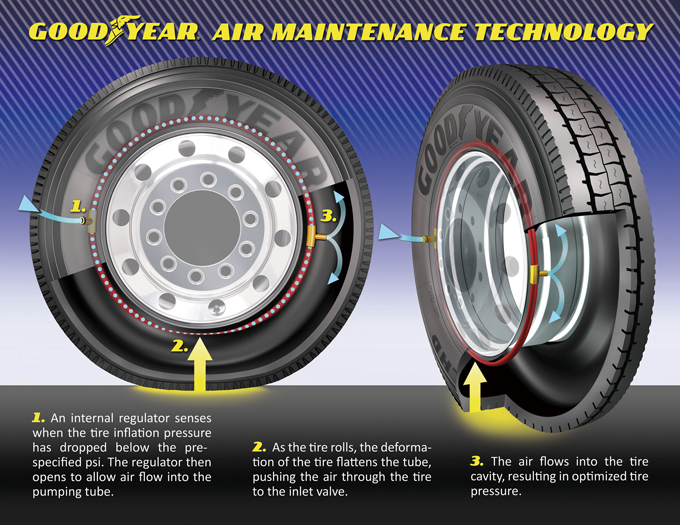
“Innovators” Awards
Fighting Deflation – Goodyear's Self-Regulating TireThe Goodyear Tire & Rubber Co. was named a 2012 award winner in the “Innovators” category for its Air Maintenance Technology (AMT). Jean-Claude Kihn, the company's chief technical officer, said that this new technology would enhance driving performance and have a positive impact on the environment through improved fuel efficiency, reduced emissions, and extended tire life.
Goodyear explained that AMT helps maintain optimum tire pressure, potentially resulting in substantial savings at the tire pump. The technology was developed, among others, by Massimo Di Giacomo Russo, John Kotanides Jr., and the firm's Air Maintenance Technology Team.
The technology works by having a peristaltic pump push air through a straw-size tube wrapped around the tire's interior circumference, similar to the way contracting muscles move food through the human intestine. The weight of the car pinches the rotating tube, forcing tiny gulps of air inside the tire.
According to Goodyear, properly inflated tires will improve the fuel efficiency of the average vehicle by 2% to 3%. Fully inflated tires also last longer and perform better, especially when cornering, thereby reducing accidents. Prototypes of tires incorporating ATM have been tested successfully, and the company hopes to begin limited field testing in the fall of 2013.
In the AMT's operation, air enters the tube through a small intake/outlet valve just above the tire's tread, and the vehicle's weight pinches the tube shut. As the tire rolls air is forced toward an internal regulator valve; if tire pressure is low, the valve opens and air is pumped in. Once pressure equalizes, the regulator valve closes and excess air escapes through the intake/outlet valve.
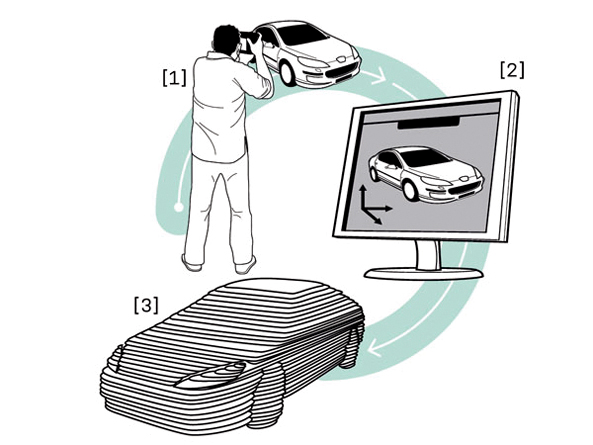
“Products” Awards
Autodesk 123DAutodesk, a dominant player in the world of professional 3D engineering software, won an award this year for its new suite of free, simple tools that enables amateurs to create, share, and print 3D models.
To apply this new technology, the user takes 20 to 30 photos of an object and then loads them into the 123D Catch software. The software analyzes the images and produces a 3D CAD model that can be edited onscreen like a digital photo. The CAD file can be sent to a 3D printer or turned into a series of 2D paper prints that the user can glue onto cardboard, cut to shape, and assemble into a real-world 3D model.
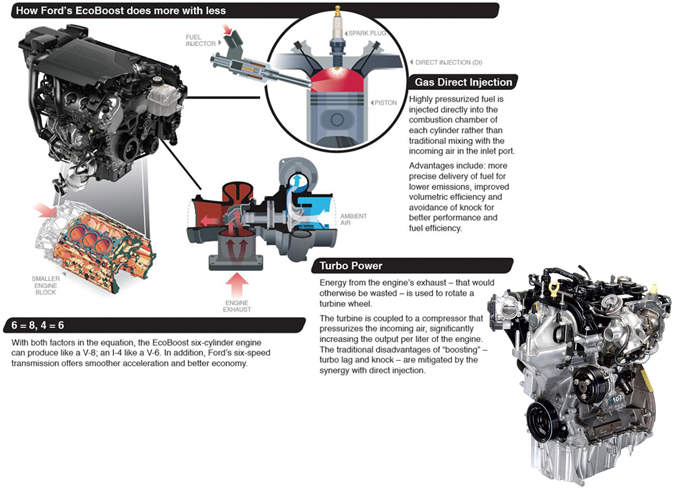
Ford 1-Liter Eco-Boost Engine
Ford took home an award for its Eco-Boost engine, which is far more efficient than the classic internal combustion engine; it can maintain performance and boost fuel economy, all without using a heavy and expensive hybrid powertrain. The new 1-liter engine has only three cylinders and roughly two-thirds the displacement of the 1.6-liter engine that is standard with the 2013 Ford Fiesta, but produces nearly the same power and more torque thanks to its turbochargers.
Ford said that while the EcoBoost is its first-ever three-cylinder engine, and one of the smallest-displacement engines it has ever built, it is not short on power or refinement. Already on sale in Europe (in Focus, C-MAX, and B-MAX models), it produces up to 125 horsepower, delivers impressive acceleration, and is loaded with technical innovations—a split cooling system, offset crankshaft, variable oil pump, direct fuel injection, and variable valve timing, among others--that make it one of the smoothest and quietest engines in Ford's global lineup. It also offers a gain of about 20% in fuel economy.
The EcoBoost was named “International Engine of the Year” in early 2012 by a jury of 76 journalists from 35 countries.
Joe Bakaj, the company's vice president, Global Powertrain, commented, “We wanted to deliver eye-popping fuel economy, surprising performance, quietness, and refinement—and all from a very small three-cylinder engine. The team responded to this seemingly impossible challenge with some really exciting innovation.”
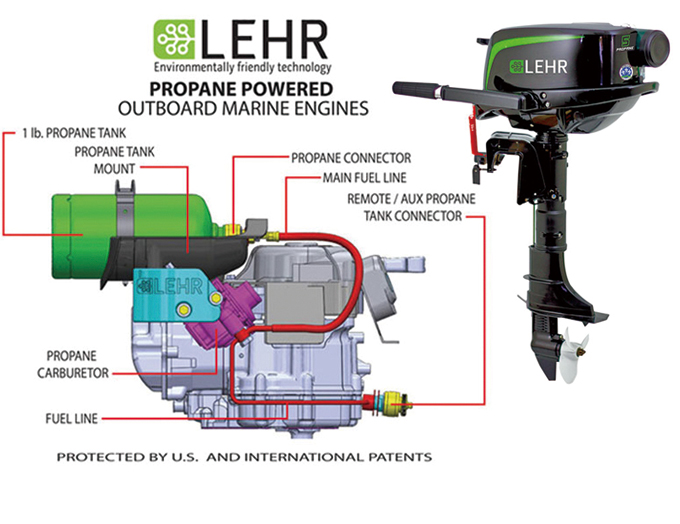
Lehr Propane-Powered Outboard Engine
Lehr Inc. won a Breakthrough Award in 2009 by putting its efficient, ultra-low-emission propane power-plant in a string trimmer, and has now taken another by extending the technology to outboard motors. It is starting small with 2.5- and 5-hp models, but plans to expand into more powerful engines. The engines are based on four-stroke powerheads and run on small propane canisters or larger remote tanks, which can be filled at any propane filling station and area s easy to connect as the ones used on barbecue grills.
Tests show that compared with gasoline, propane is cheaper, has a higher octane rating, produces fewer harmful emissions, contains no detergents or oil to clog injectors and foul spark plugs, is safer (with a flash point of 940o F), will not contaminate water or soil, can reduce dependence on foreign oil, will not degrade over time, has no ethanol issues, and requires less maintenance. Propane is also easier on machinery and operators, requiring less winterization than gasoline engines and avoiding flooding during cold starts because the fuel is gaseous.
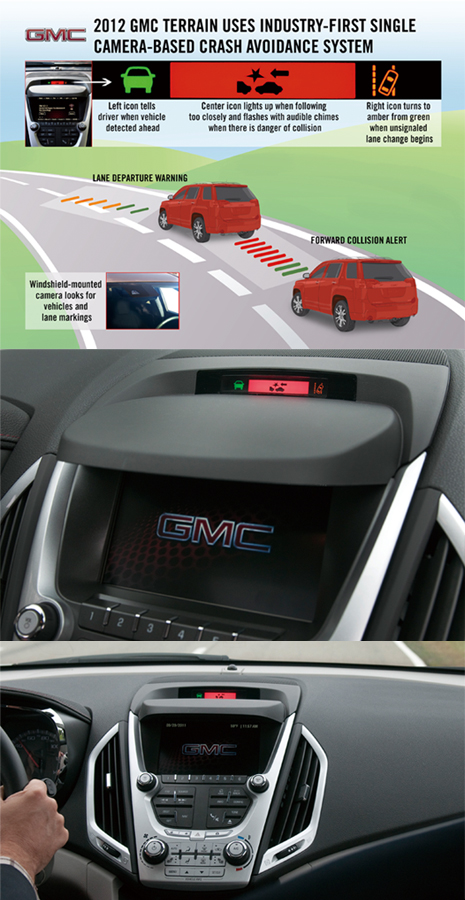
General Motors (GM) won an award for its first practical and cost-effective single-camera vision system for crash avoidance in passenger cars, which is incorporated in the GMC Terrain.
This camera used in the system is mounted behind the rearview mirror and watches the world much as humans do, detecting shapes and their positions relative to the car. Using visual information from a 37-degree field, the system warns the driver of possible collisions and unintentional lane departures.
GM reports that the Terrain's new active safety system uses a high-resolution digital camera that looks for shapes of vehicles and lane markings, and warns the driver with an audio signal and high-mounted visual display if he or she is following another vehicle too closely, if a collision is imminent, or when departing a lane without signaling first.
The system examines each frame captured by the camera—about 14 frames per second—searching for shapes characteristic of vehicles; when a vehicle is detected, it is checked over successive frames for changes in size, which are used to calculate time to collision. The system also uses speed, directional change, and application of accelerator and brake pedal to determine when to alert the driver.
The warning display contains green “vehicle ahead” and “lanes detected” icons, as well as flashing red “forward collision alert” and amber “lane departure warning” icons, all accompanied by warning chimes. The forward collision alert operates at speeds above 25 miles per hour; if a collision is predicted to be imminent, the brakes are pre-charged for maximum braking.




